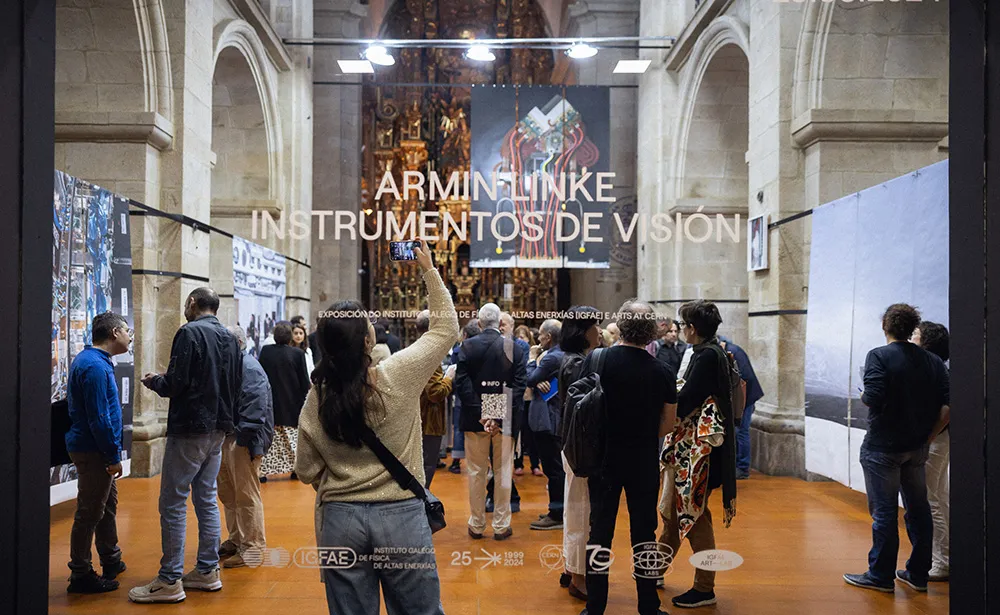O IGFAE acolle unha reunión internacional sobre desenvolvemento de espectrómetros solenoides



27.08.2024

A exposición Instrumentos de Visión, do artista Armin Linke, amplía a súa estadía en Santiago de Compostela ata o sábado 21 de setembro. O proxecto, froito da colaboración do Instituto Galego de Física de Altas Enerxías (IGFAE) e Arts at CERN, conmemora, neste 2024, o 25º aniversario do IGFAE e os 70 anos da fundación da Organización Europea para a Investigación Nuclear (CERN). A mostra, que xa suma máis de 30.000 visitas desde a súa inauguración, permanecerá aberta na Igrexa da Universidade en horario de martes a sábado, de 11.00 a 20.00 horas.
Instrumentos de Visión compila máis de 20 anos de traballo do fotógrafo e cineasta Armin Linke (Milán, 1966), a partir da observación das investigacións realizadas en grandes infraestruturas experimentais como o CERN, o Laboratori Nazionali di Gran Sasso (L’Aquila, Italia), ou o Institute for Quantum Optics and Quantum Information (IQOQI), de Innsbruck (Austria). Para esta ocasión, Armin Linke realizou unha serie de obras nas que se recolle o labor científico do persoal do IGFAE, presente nalgunha das máis importantes colaboracións científicas internacionais en física de partículas, como o experimento LHCb do CERN.
Este proxecto está comisariado por Mónica Bello (Santiago de Compostela, 1973), directora de Arts at CERN, o programa de arte desta organización científica, e enmárcase na aposta realizada nos últimos anos polo ArtLab do IGFAE, co obxectivo de abrir novos espazos de conexión coa sociedade. Así, Instrumentos de Visión contribúe tamén ao diálogo entre a arte contemporánea e as diversas liñas de investigación do IGFAE.
Novas actividades divulgativas
Co gallo da ampliación da apertura da mostra, a Igrexa da Universidade acollerá novas actividades divulgativas arredor de Instrumentos de Visión. Por unha banda, engadiranse novas datas ás visitas guiadas. Ademais deste martes, 27 de agosto, en horario de 19.00 a 20.00 horas. Haberá unha nova oportunidade o xoves 19 de setembro á mesma hora. O rexistro, gratuíto, pode realizarse a través da web da exposición, instrumentosdevision.igfae.usc.es. Esta actividade realízase co apoio de Horta Coslada.
Ademais, coincidindo co comezo do curso académico, os centros educativos da contorna poderán coñecer, no marco da exposición, algúns dos “instrumentos de visión” utilizados polo persoal do IGFAE para amosar os compoñentes fundamentais da materia, como a cámara de néboa ou o detector portátil MiniPix, desenvolvido polo CERN.
Finalmente, o venres 20 de setembro terá lugar na Igrexa da Universidade unha conversa sobre a influencia das achegas da física de partículas á sociedade no relativo ás narrativas contemporáneas. Participarán Mario Regueira (escritor e crítico literario), Iria Veiga (psiquiatra) e Carlos Salgado (director do IGFAE). Esta actividade está organizada en colaboración coa Asociación Galega da Crítica.
Sobre o IGFAE
O Instituto Galego de Física de Altas Enerxías (IGFAE) é un centro de investigación creado en 1999 pola Universidade de Santiago de Compostela e a Xunta de Galicia. Naceu co obxectivo de coordinar e fomentar a investigación científica e técnica nos campos da Física de Alta Enerxía, Partículas e Nuclear, e áreas relacionadas como a Astrofísica, a Física Médica ou a Instrumentación. Desde os seus inicios, o persoal do IGFAE participou nalgunhas das maiores instalacións experimentais do mundo, como o Gran Colisionador de Hadróns (LHC) do CERN.
O traballo científico do IGFAE e a súa proxección internacional fíxoo merecedor do recoñecemento como Unidade de Excelencia María de Maeztu, que outorga a Axencia Estatal de Investigación. É, ata o momento, o único centro galego que obtivo este prestixioso selo. O IGFAE conta tamén coa acreditación de excelencia da Rede Galega de Centros de Investigación, concedida pola Xunta de Galicia.